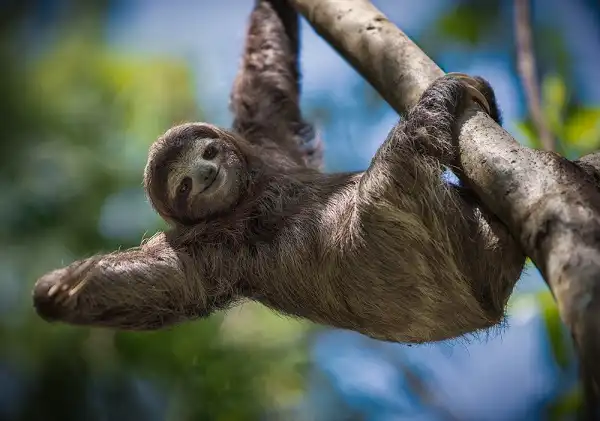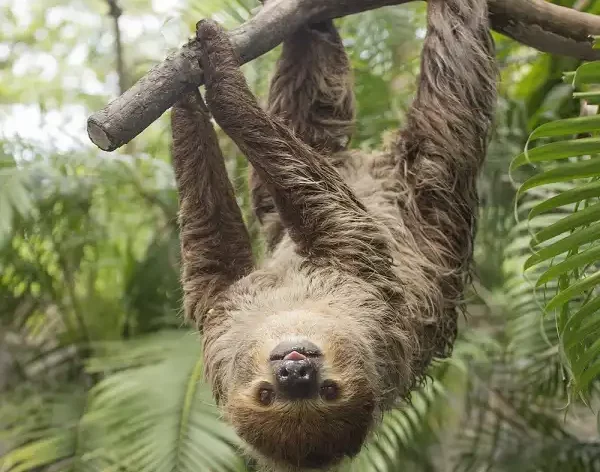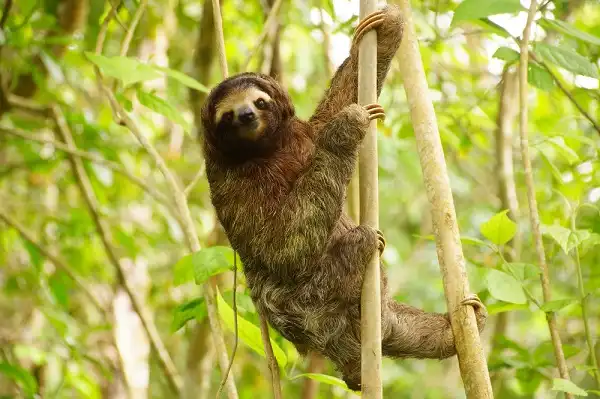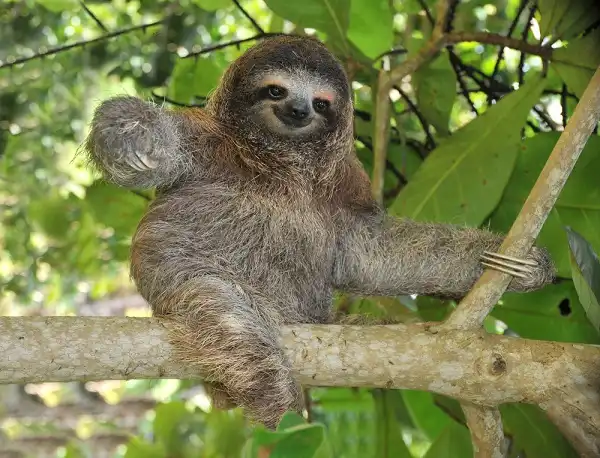If you want a pet that is calm, low-maintenance, and totally adorable – look no further than the sloth. Native to rainforests of Central and South America, these slow-moving mammals have become increasingly popular among pet owners thanks to their endearing nature and relaxed personalities. Sloths are fascinating animals that require specialized care in order to live happy, healthy lives; read on for an overview of their unique behaviors and biological needs.

Sloth Description
Sloths are small, arboreal mammals. They have long, curved claws for gripping branches and sharp teeth for eating leaves. Most sloths have three toes on each front foot, with a longer fourth toe on their hind feet. The fur of the sloth is thick and coarse and can be grayish or yellowish-brown in color. Sloths spend most of their time hanging upside down from tree branches, where they will often remain motionless for hours at a time while they feed on leaves or sleep. They move very slowly – even when walking on the ground – so much so that algae is able to grow in patches on their coats! Despite this slow pace, sloths are actually quite agile climbers and swimmers, thanks to their powerful arms and long claws.
Sloth Habitat
Sloths inhabit a variety of habitats in Central and South America. They are most commonly found in tropical rainforests, but they also live in dry deciduous forests, swampy areas and even high-altitude cloud forests. Sloths like to stay close to the ground when they’re not hanging upside down from tree branches, so their homes usually contain plenty of low shrubs and bushes for them to curl up into during the day. Despite living in trees for most of their lives, sloths actually spend about half of their time on the ground – walking or just lying around. When it’s time to move from one tree to another (or if they need to escape predators), sloths will climb down and use their long claws to help them move slowly but efficiently across the ground. Sloths are very particular about where they live; they usually choose trees that have thick canopies with plenty of leaves for protection from the sun, as well as branches that provide easy access to food. Sloths also prefer to stay close to water sources so they can easily hydrate themselves.
Sloth Diet
Sloths in the wild subsist on a diet primarily of leaves, shoots, and bark from trees. They are also known to supplement this diet with small animals such as frogs or lizards. In captivity, sloths can be fed a variety of fresh fruits and vegetables (such as apples, bananas, carrots, and leafy greens), as well as commercial primate diets that are specifically designed for sloths. It is important to remember that sloths have very slow digestive rates; they should not be fed large quantities at one time, but rather in smaller portions throughout the day. It is also important to ensure your sloth has access to plenty of fresh water so they can stay hydrated! Sloths will only drink from puddles and streams in the wild, so it is important to provide them with a shallow bowl of water to drink from in captivity.

Sloth Size
Sloths are relatively small animals, typically growing between approximately 15 – 25 inches in length. They have long arms and legs, a short neck, and a round head with small ears. Sloths’ slow lifestyles make them well adapted to their habitats; they are able to conserve energy by staying still for extended periods of time while they wait for food to come within reach. This also helps them stay hidden from predators in the treetops! Sloths may be small, but they have big personalities and are beloved by many. They may not be the fastest creatures in the world, but they certainly make up for it with their charm!
Sloth Lifespan
The average life span of a sloth in the wild is between 10 and 20 years. However, some species can live up to 40 years if they are able to avoid predators and successfully find food sources in their habitat! In captivity, sloths can live longer as they don’t have to worry about predation or finding food—but it is important for carers to provide them with a balanced diet and enrichment activities that keep them stimulated. Sloths are unique creatures with captivating personalities; understanding their needs and providing them with proper care is essential for ensuring their longevity in captivity. If you’re thinking about adding a pet sloth to your family, make sure you do your research first—it may take some extra effort, but your sloth will thank you for it! Sloths are an amazing species that deserve our respect and appreciation. With proper care and respect for their needs, sloths can live long, happy lives in captivity. So if you’re thinking about adding a sloth to your family, make sure you do your research first—your patience and dedication will be rewarded with the joy of having a pet sloth in your home!
Sloth Behavior
Sloths are solitary animals, usually only interacting with each other during mating season. They have a slow and relaxed manner of moving, and can often be seen taking naps in the treetops. Sloths are nocturnal creatures and spend most of their time sleeping during the day and foraging for food at night. During the night, sloths will climb down from the safety of their trees to search for leaves, shoots, fruit, and small animals to eat. Sloths are known for their unique sleeping positions; they often wrap their long arms and legs around branches or even hang upside down from them! This has earned them the nickname “the tree hugger”. Sloths also possess excellent camouflage capabilities; their fur blends in with their surroundings making it difficult for predators to spot them in the tree canopy. Sloths communicate mainly through vocalizations such as a high-pitched trill or a low rumbling sound that can be heard up to 20 meters away. These vocalizations are used by sloths to communicate distress calls, alerting nearby family members or potential mates of danger. In addition to vocalizing, sloths also use scent marking as a form of communication; they secrete oils from glands on their face and anogenital area which they rub onto tree branches and other objects to indicate territory boundaries or attract a mate.

Sloth Speed
Sloths are not known for their speed. They typically move at a maximum of 15 meters per minute, and can take up to 12 hours to cover one kilometer! Compared to the fastest land animal in the world—the cheetah—which can reach speeds of up to 75 kilometers per hour, sloths seem incredibly slow! However, this slow pace is perfectly suited for their lifestyle. Sloths spend most of their time in the trees and don’t need high speeds to search for food or escape predators. Their slow movement helps them conserve energy and allows them to hang from branches without expending too much energy. Additionally, sloths have long arms that help them climb higher into trees and reach food sources that are out of reach for other animals. Despite their slow movement, sloths can still be agile when needed. When threatened by a predator, they may swing from branch to branch or even drop from the tree and take cover on the ground. Sloths have also been known to “run” short distances in order to evade predators. So while sloths may not be the fastest animals in the world, they certainly possess impressive abilities that help them survive in the wild!
Sloth Hunting
Sloths have evolved to become relatively safe from predators due to their slow movement and excellent camouflage capabilities. However, they are still vulnerable to certain animals such as jaguars, ocelots, and harpy eagles. Jaguars in particular are known to hunt sloths by climbing the same tree as them and using their claws and teeth to bring them down. In addition to predation from other animals, humans also pose a threat to sloth populations through hunting for food or fur. Sloth meat is considered a delicacy in some cultures, with its fatty flesh being highly sought after by hunters. Similarly, the fur of two-toed sloths is considered valuable for making clothing or other items. The destruction of habitat due to deforestation and other human activities is also a major threat to sloth populations around the world.

Conclusion
Sloths are amazing animals with unique adaptations that make them perfectly suited to their rainforest habitat. Although they may appear slow and sluggish, sloths possess impressive abilities that help them survive in the wild. Unfortunately, humans pose a threat to sloth populations through hunting for food or fur and the destruction of their habitats. However, there is still hope for these creatures if we take action to protect them and their ecosystems. With proper care and respect for their needs, sloths can live long, happy lives in captivity too! Thanks for learning about the fascinating world of sloths today!
Frequently Asked Question

